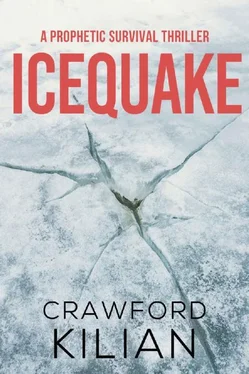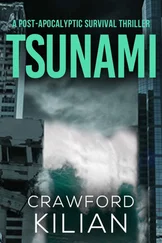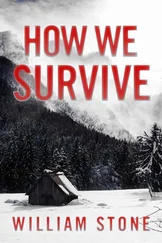Crawford Kilian - Icequake - A Prophetic Survival Thriller
Здесь есть возможность читать онлайн «Crawford Kilian - Icequake - A Prophetic Survival Thriller» весь текст электронной книги совершенно бесплатно (целиком полную версию без сокращений). В некоторых случаях можно слушать аудио, скачать через торрент в формате fb2 и присутствует краткое содержание. Год выпуска: 2017, Издательство: Venture Press, Жанр: Фантастика и фэнтези, Прочие приключения, на английском языке. Описание произведения, (предисловие) а так же отзывы посетителей доступны на портале библиотеки ЛибКат.
- Название:Icequake: A Prophetic Survival Thriller
- Автор:
- Издательство:Venture Press
- Жанр:
- Год:2017
- ISBN:нет данных
- Рейтинг книги:4 / 5. Голосов: 1
-
Избранное:Добавить в избранное
- Отзывы:
-
Ваша оценка:
- 80
- 1
- 2
- 3
- 4
- 5
Icequake: A Prophetic Survival Thriller: краткое содержание, описание и аннотация
Предлагаем к чтению аннотацию, описание, краткое содержание или предисловие (зависит от того, что написал сам автор книги «Icequake: A Prophetic Survival Thriller»). Если вы не нашли необходимую информацию о книге — напишите в комментариях, мы постараемся отыскать её.
Icequake: A Prophetic Survival Thriller — читать онлайн бесплатно полную книгу (весь текст) целиком
Ниже представлен текст книги, разбитый по страницам. Система сохранения места последней прочитанной страницы, позволяет с удобством читать онлайн бесплатно книгу «Icequake: A Prophetic Survival Thriller», без необходимости каждый раз заново искать на чём Вы остановились. Поставьте закладку, и сможете в любой момент перейти на страницу, на которой закончили чтение.
Интервал:
Закладка:
“Where’s Steve?” Jeanne asked.
“He’s already inside. Up you go,” Will smiled, helping her through the door. Penny followed, and found the rest of the party in the passenger compartment. Steve and Al were discussing the flight plan; then they went forward to the flight compartment while the others buckled themselves in and pulled on light helmets, which were plugged into the helicopter’s intercom. As she fumbled with her camera, Penny heard Al’s voice in her headphones, a parody drawl:
“Ah tole ’um, ah said, “Orville an’ Wilbur, you all will nevuh git that thang off of the ground.” Ah did. An ah still thank those boys shoulda stuck to bah-sickles. Ah do. Ain’t nobody evuh crashed in thuh Annoctic on a bah-sickle. Idnat right? Nevuh!”
The helicopter lifted off in a cloud of dust-fine snow, gained altitude, and tilted away towards the mountains.
Chapter 2 – Beardmore
In the upside-down world of the Antarctic, where the sun shone all day in December and winter was in July, it made a kind of sense to Penny that directions should be reversed as well. Have you travelled by ‘the Grid’, an arbitrary act of cartography. On the Grid the North Pole was in mid-Atlantic, the South Pole in the Pacific and the equator ran through the true South Pole. To fly from Shacktown to the mainland, they would be going Grid North; this afternoon Al would fly Grid South to Ross Island, where McMurdo Station and its airstrip, Williams Field, were located. Penny reminded herself of this change in bearings as Shacktown fell away below them and swung out of the field of vision.
The mountains ahead stood out with unnatural sharpness in the clear air. But, from an altitude of almost a kilometre, Penny could see that the weather was already changing. The sky was still cloudless, but patches of ice fog had begun to form over the Shelf and around the glacier mouths.
God, if the weather breaks before we can evacuate, I’ll go nuts.
She pushed the thought out of her mind and squinted through the window. With each moment, the view changed: shadows on the Shelf and the mountains went from deep blue to black to purple; snow was an impossibly pure white one instant and a rich cream the next. The glaciers were densely textured, their surfaces patterned with countless crevasses and tinted blue, green, amber, mauve and black. Penny took a few pictures, though it was clumsy to handle the camera while wearing heavy mittens.
The flight to the first remote was brief. They landed on a shelf of bare, pinkish-beige rock near the mouth of Ramsey Glacier. The remote was a small prefab hut, bolted to the rock. A small windmill, its blades scarcely turning, rose from the roof of the hut, and there was also an antenna array made useless by the radio blackout.
They stepped out into silence. The helicopter’s rotors murmured into stillness; mukluks scuffed on the smooth rock. Otherwise there was a quiet such as few people ever experience. It seemed much colder here than at the station; Penny’s eyes began to water at once, and a tear froze halfway down her cheek. Her nose began to run again, and she appreciated the absorbent backs of her bear-paw mitts. Her nostrils hurt, and when she tried breathing through her mouth, the air made her fillings ache.
“Welcome to the Dufek Coast,” Steve said to Penny. “Let’s get inside.”
Will and Jeanne, however, would have to stay outside for a while. They collected their gear and set out down the slope to the glacier’s edge less than a hundred metres away. Up this close, it looked dingy and grey, almost like old city snow. The surface was rough, with many sastrugi and ice thrusts taller than a man. It was impossible, as Will and Jeanne were demonstrating, to take more than four steps without clambering over a hummock or striding across a crevasse.
After watching them for a minute, Penny turned and followed the rest of the party into the hut. Steve had already turned on the lights and heater.
“There are over three dozen of these huts all over West Antarctica, and they let us gather a hell of a lot of data,” Steve told her. Most of the hut was taken up with seismographs, tilt-and creep-meter equipment, a small radio and the windmill-charged batteries that powered everything. A double bunk and some shelving gave the hut some value as an emergency shelter as well. Penny slid into the bottom bunk to keep out of the way, while Al climbed into the top one. Steve and Tim studied the equipment.
“They’re taking forever to set up that damned shot,” Tim growled. He pressed the video outlet of the seismograph, and on its screen watched the tracks made by the glaciologists’ footsteps.
“As soon as they fire the shot, I’ll collect the tape reel,” Steve said to Tim. “You get the other tapes.”
“Right.” Tim pulled out the reels that held two months’ worth of seismic and meteorological data. Played back through a computer, they would provide an exquisitely precise account of the movements of earth, ice and air around the hut.
The video screen erupted into jagged multi-coloured lines as the hut shook from the thump of the shot. Steve pressed a button and the seismograph spat out a strip of paper, the hard-copy record of the shock waves’ path through the ice to the bed of the glacier and back again. He shoved the paper in his anorak pocket, removed the tape reel and replaced it with a new one.
“At least that’ll record the next three months before it runs out. Let’s go.”
They all helped Will and Jeanne carry their gear back to the helicopter. After her few minutes of relative warmth inside the hut, Penny felt the cold more than ever.
“Ice is full of bloody great crevasses,” Will panted as they walked up the slope from the glacier. “We nearly went in a couple of times. The glacier’s moving fast near the bottom, and that breaks up the surface.”
“How can you tell it’s moving?” Penny asked.
Will turned and pointed to a fluorescent orange pennant hanging from a bamboo pole some distance down the glacier. “I planted that marker three months ago — beginning of December. It’s moved over a hundred metres downstream. Normally the Queen Maud glaciers travel less than half that distance in three months — they’re doing well to cover three hundred metres in a bloody year.” He laughed as they threw the geophones into the helicopter. “Maybe that’s your famous surge right there, Steve.”
“Maybe.” Steve didn’t look amused. “But I doubt it.”
He really did have a bee in his bonnet about surges, Penny thought. Up to a point she could buy his arguments. He had recorded ‘seismic swarms’ in the Queen Maud Range for two years running now — micro-earthquakes that often foreshadowed a major quake. As far back as the late ’50s, the Kiwis and others had recorded similar tremors around Ross Island; they’d called them ‘icequakes’ on the assumption that they were caused by big tabular icebergs calving off the edge of the Shelf. Will and Jeanne had found unusual amounts of radon gas dissolved in the sea water under the Shelf — another sign, though not a reliable one, that a quake was imminent. The freshness of the water under the Shelf also indicated that more ice than usual was melting under the ice sheet and leaking down under the glaciers into the sea. But that ice sheet was up to three kilometres thick; as Tim had said in one argument with Steve, expecting a quake to move that immense mass was like expecting a gnat to push the meringue off a pie with one shove. Steve had laughed at that, but he hadn’t changed his mind.
They followed the mountains Grid East for two hundred kilometres, past bare brown mountain slopes and blinding glaciers. The ice fog was thickening, obscuring much of the Shelf off to their right, but the peaks of the Queen Maud Range stood out sharply against the deep, empty blue of the sky. The helicopter curved around Mount Kyffin, an ice-drowned island, and then they were over the Beardmore.
Читать дальшеИнтервал:
Закладка:
Похожие книги на «Icequake: A Prophetic Survival Thriller»
Представляем Вашему вниманию похожие книги на «Icequake: A Prophetic Survival Thriller» списком для выбора. Мы отобрали схожую по названию и смыслу литературу в надежде предоставить читателям больше вариантов отыскать новые, интересные, ещё непрочитанные произведения.
Обсуждение, отзывы о книге «Icequake: A Prophetic Survival Thriller» и просто собственные мнения читателей. Оставьте ваши комментарии, напишите, что Вы думаете о произведении, его смысле или главных героях. Укажите что конкретно понравилось, а что нет, и почему Вы так считаете.












